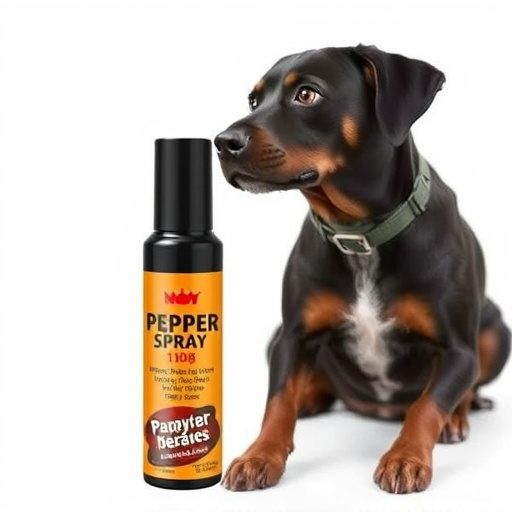Dog deterrent sprays effectively discourage canines by triggering an unpleasant response through key active ingredients, with a safe spraying distance of 10-25 feet (3-7 meters). This range varies based on wind speed, terrain, and surface type, requiring adherence to manufacturer instructions for optimal results while minimizing harm to bystanders. Always prioritize safety and consistent application within this range for effective dog behavior correction.
Dog deterrent spray has emerged as a popular tool for managing canine behavior. Understanding its effective range is crucial for safe and responsible use. This article delves into the mechanics behind dog deterrent sprays, exploring factors that influence their reach, including wind speed and terrain. We guide owners through best practices for safe application, addressing common misconceptions about spray distance. Additionally, we compare deterrents to alternative methods, offering insights on the most effective and humane approaches to keeping dogs at bay while maintaining a safe spraying distance.
- Understanding Dog Deterrent Spray Mechanics
- Factors Influencing Effective Range
- Safe Application Practices for Owners
- Common Misconceptions About Spray Range
- Comparative Analysis with Alternative Methods
Understanding Dog Deterrent Spray Mechanics
Dog deterrent sprays are designed to create an unpleasant experience for dogs, discouraging them from approaching or engaging with certain areas. However, understanding the mechanics behind these sprays is key to their effective use. The active ingredient in dog deterrents, often a blend of natural and synthetic chemicals, triggers a sensory response that disrupts a dog’s behavior patterns. This usually involves an immediate reaction when the spray comes into contact with the dog’s skin or eyes, causing irritation and temporarily overwhelming its senses.
The safe spraying distance for dogs is crucial information to master. Typically, these sprays are effective within a range of 10-15 feet (3-4.5 meters), but this can vary based on factors like wind speed and direction, the spray’s concentration, and the dog’s sensitivity. It’s essential to adhere to the product instructions and consider the environment in which you’ll be using the deterrent to ensure optimal results without causing harm or stress to nearby dogs or people.
Factors Influencing Effective Range
Several factors determine the effective range of dog deterrent spray, crucial for ensuring safety and minimizing over-spray. The safe spraying distance for dogs generally ranges from 10 to 25 feet (3 to 7 meters), though this can vary based on the product’s concentration and weather conditions. Wind speed and direction play a significant role; a stronger breeze can carry the spray beyond the intended range, potentially affecting bystanders or other pets.
Terrain and surface type also influence the spray’s reach. Spraying up a hill or onto rough, uneven ground may result in reduced coverage area due to gravity and disruption of the spray pattern. Conversely, flat, smooth surfaces like concrete or tarmac can extend the effective range slightly. Always follow manufacturer instructions regarding spraying techniques and distances for optimal results while minimizing potential harm.
Safe Application Practices for Owners
When using dog deterrent spray, it’s crucial to prioritize safety and adhere to best practices. Always apply the spray at a safe distance from your pet, typically 10-15 feet (3-4.5 meters), to avoid direct inhalation or skin irritation. This distance ensures that any misting doesn’t come into contact with the dog, minimizing potential harm.
Follow instructions on the product label carefully, using only the recommended amount and frequency. Never use deterrent spray in enclosed spaces or where airflow is limited, as this can trap odor molecules and potentially cause respiratory distress for your pet. Store the spray out of reach from animals and children to prevent accidental exposure, and always test the spray in a controlled environment before applying it near your dog to ensure they are not sensitive to the scent.
Common Misconceptions About Spray Range
Many dog owners and enthusiasts hold several misconceptions about the effective range of dog deterrent spray. One common misunderstanding is that spraying directly at a dog will immediately stop it in its tracks. However, this isn’t entirely accurate. Dog deterrent sprays work best when applied within a safe spraying distance for dogs, typically ranging from 10 to 25 feet (3 to 7 meters). Spraying too close might startle the animal without providing enough time for it to associate the spray with the behavior you’re trying to correct.
Another misconception is that one can simply spray as hard or as close as possible. The force and proximity of the spray aren’t as important as the consistent application within the recommended range. Over-spraying, especially at close ranges, might lead to accidental misting on humans or other pets nearby, which could be unpleasant for them and potentially counterproductive in training. Always remember that safety and effectiveness go hand in hand when using dog deterrent sprays.
Comparative Analysis with Alternative Methods
When comparing dog deterrent spray to other methods, it’s clear that safe spraying distance for dogs plays a crucial role in its effectiveness. Unlike training methods or electronic fences, which have specific ranges and limitations, spray deterrents offer a more versatile solution. The effective range of dog deterrent spray can reach up to 30 feet (10 meters), allowing for coverage of larger areas without the need for extensive setup.
This method stands out for its immediate impact and convenience. Unlike training techniques that require consistent reinforcement, a single application of deterrent spray can create a lasting impression on dogs for weeks. Moreover, it’s environmentally friendly and non-invasive, making it a preferred choice for pet owners seeking humane alternatives without compromising on control and protection.
Dog deterrent spray can be an effective tool for managing canine behavior, but understanding its mechanics and safe application practices is crucial. The effective range varies based on several factors, including the type of spray and environmental conditions. By adhering to recommended safety guidelines and dispelling common misconceptions about the spray’s reach, owners can ensure successful and responsible use. When compared with alternative methods, dog deterrent spray offers a non-lethal, quick-acting solution for addressing unwanted behaviors within an optimal safe spraying distance for dogs.
